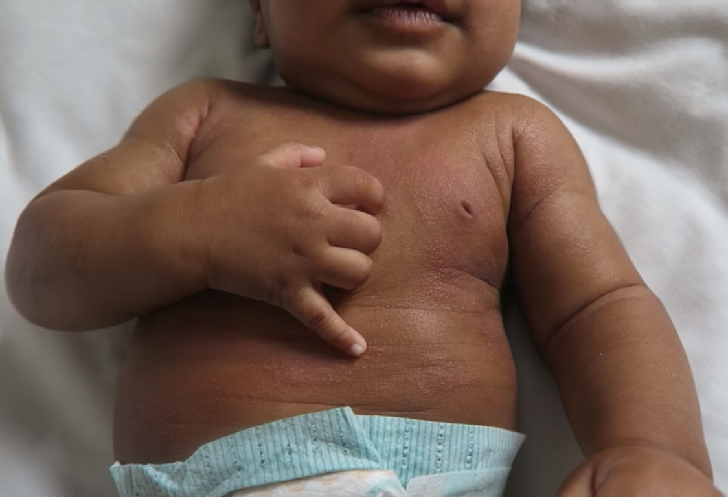Your child comes home from school covered in little red dots. Is it chickenpox? Heat rash? Is it contagious? So that you can correctly identify your child’s rash and whether or not you should take him/her to a doctor, Lauren Adler, MD, FAAP, a pediatrician, has listed the 10 most common kids’ skin rashes and what to do about them.
The 10 most common pediatric rashes are:
1. Ringworm.
Brought on by a fungus that infects the skin and causes a scaly, bumpy red patch to form on the infected area. It is contagious and can be spread by contact or by sharing clothes that have also come in contact with the infected area. Treatment: Apply an antifungal cream to the area for 7-10 days until the infection resolves.
2. Fifth Disease
Usually mild and goes away without treatment. It typically starts with flu-like symptoms and can be identified by a bright red rash on the cheeks (“slapped cheek appearance”). A lacey rash on the body follows. Since a virus causes fifth disease, antibiotics should not be used for treatment.
3. Chickenpox
Chickenpox used to be very common in young children but today we see it much less frequently due to routine vaccination programs. Caused by the virus varicella, chickenpox generally starts as a fever and then manifests as cold symptoms and a rash. The rash is typically a mix of blisters, spots and crusted scabs are itchy, and lasts for about a week. Children with an active chickenpox infection are contagious until all of the blisters crust over.
4. Impetigo
Caused by common bacteria found on the skin and needs to be treated with an antibiotic ointment. The rash itself looks red, oozy and blistery, then may develop a yellowish crust. It spreads by contact and scratching makes it worse.
5. Warts
Caused by a virus, warts can spread both from person to person and to other parts of the body. Most commonly, warts appear on the hands but they can be found anywhere. Most warts resolve on their own, but there are many over-the-counter medications available that can help speed up the process.
6. Heat Rash (“Prickly Heat”)
Common in young babies, heat rash is caused by blocked sweat glands and results in a red, pimply eruption on the head and neck. To prevent, make sure to dress your infant appropriately (not too hot, not too cold). Generally, heat rash goes away on its own.
7. Contact Dermatitis
Appears as a collection of small red pimples or bumps on the skin that has been exposed to an allergen, such as specific foods, lotions, chemicals or plants, such as poison ivy. The rash starts within 1-2 days of exposure, depending upon the sensitivity, and can last as long as the contact with the allergen continues or until the rash heals, which may take 1-2 weeks. Topical steroids can help lessen the symptoms.
8. Hives
Resulting from an allergic reaction, hives appear as small, red, itchy bumps or welts, which are often painful. Although hives themselves are not dangerous, if your child develops breathing trouble, such as coughing and/or wheezing, it might signal a more serious allergic reaction requiring immediate medical attention. Antihistamines are the standard treatment for hives.
9. Scarlet Fever
A prevalent illness that begins with a sore throat, fever and other nonspecific complaints, scarlet fever is caused by streptococcal infection. Scarlet fever is very contagious, and it is imperative to treat the underlying strep infection with antibiotics.
10. Atopic Dermatitis (Eczema)
Eczema, also known as atopic dermatitis, is common in children with allergies and asthma. It appears as an itchy, red patch that typically shows up on the cheeks, elbows or around the knees. Treating the rash with lubricating lotions, ointments or creams usually improves the symptoms but sometimes topical steroids are required.
Consult your child’s doctor promptly if a rash:
➤Worsens
➤Lasts longer than a week
➤Shows signs of local infection (oozing, redness or swelling of the skin)
➤Occurs together with fever, chills, swollen glands or other symptoms of infection (a sore throat, cough, headache, nasal congestion, etc.)
➤Occurs together with symptoms that suggest an autoimmune disorder, such as recurring fever, malaise, fatigue, unexplained weight loss or joint swelling
➤If your child is suffering from a painful, itchy rash, please see one of our pediatricians
If your child has a rash that is not going away or is getting worse, please make an appointment with ar pediatricians. They will determine the best course of treatment so your child can start feeling better soon.
